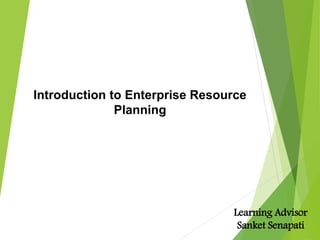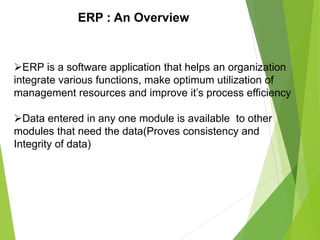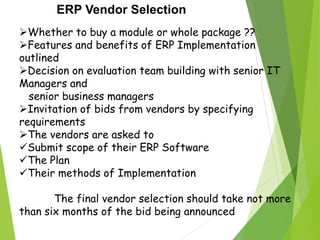Introduction to ERP
- 1. Introduction to Enterprise Resource Planning Learning Advisor Sanket Senapati
- 2. Evolution of Enterprise Application A method of using computer technology to plan for the raw materials required for production in line with the expected demand was developed(MRP) in Mid 1960s A number of businesses had started using this method to manage their inventory effectively by mid 1970s Many companies realized the need for automation in their capacity planning, production scheduling and shop floor control functions in the 1980s which gives rise to MRP II with a central database which recorded,generated and managed reports on various activities In late 1980s ,MRP II transformed into ERP where HR,Financial accounting etc were integrated with MRP II
- 3. 2000s Extended ERP 1990s Enterprise Resource Planning (ERP) 1980s Manufacturing Resources Planning (MRP II) 1970s Material Requirements Planning (MRP) 1960s Inventory Control Packages
- 4. ERP : An Overview ERP is a software application that helps an organization integrate various functions, make optimum utilization of management resources and improve it’s process efficiency Data entered in any one module is available to other modules that need the data(Proves consistency and Integrity of data)
- 5. What is ERP? The practice of consolidating an enterprise’s planning, manufacturing, sales and marketing efforts into one management system. Combines all databases across departments into a single database that can be accessed by all employees. ERP automates the tasks involved in performing a business process. 5
- 6. How Do ERP Systems Work? 6 Employees Managers and Stakeholders Central Database Reporting Applications Human Resource Management Applications Financial Applications Manufacturing Applications Inventory And Supply Applications Human Resource Management Applications Service Applications Sales and Delivery Applications Sales Force And Customer Service Reps Customers Back-office Administrators And Workers Suppliers
- 7. ERP Requires Strong executive support to implement Process approach rather than “silos” Change in business procedures (BPR) Change in organizational structure, culture, strategy Technology change
- 8. ERP Difficult to install Very large and complex software Provides info about all aspects of the business -- worldwide Reduces inventory, waste Easy communication with customers, suppliers
- 9. Before ERP Multiple systems, different interfaces, difficult to extract info about customers, sales,... Hard to maintain, many languages, databases, inconsistencies Can take weeks or months to obtain info about customers, or where systems changes are needed
- 10. An ERP Example: Before ERP 10 Customers Customer Demographic Files Sales Dept. Vendor Orders Parts Accounting Accounting Files Purchasing Purchasing Files Order is placed with Vendor Invoices accounting Inventory Files Warehouse Checks for Parts Calls back “Not in stock” “We ordered the parts” “We Need parts #XX” “We ordered the parts” Sends report Sends report Sends report Ships parts
- 11. After ERP Integrated systems Consistent interface One database Access to current data Improved planning capabilities Multinational capabilities
- 12. An ERP Example: After ERP 12 Database Customers Sales Dept. Purchasing Warehouse Accounting Vendor Inventory Data If no parts, order is placed through DB Orders Parts Order is submitted to Purchasing. Purchasing record order in DB Order is placed with Vendor And invoices accounting Financial Data exchange; Books invoice against PO Books inventory against PO Ships parts
- 13. System automatically: Schedules shipping Reserves material Orders parts from suppliers Schedules assembly Checks customer credit limit Updates sales & production forecasts Creates MRP & bill-of-material lists
- 14. System automatically: Updates salesperson's payroll commission travel account Calculates product cost & profitability Updates accounting, financial records
- 15. Definition of Enterprise Architecture The enterprise architecture is the organizing logic for a firm’s core business processes and IT capabilities captured in a set of principles, policies and technical choices to achieve the business standardization and integration requirements of the firm’s operating model.
- 16. Enterprise Architecture Planning ERP Architecture is multi layered which communicates and transact among the members of Supply Chain with ease It’s comprises hardware layer, relational database layer,database access layer and application software layers) One of the first activities of ERP A ERP architecture ensures management that the ERP system supports the business processes intended
- 17. Does Your IT Architecture Look Like…
- 18. Why Enterprise Architecture IT costs too much Costs of managing complexity Eliminate redundancy Growing IT ecosystem Demanding rate of change Need for info sharing Outsourcing (BPO) Future-proofing If you don’t have strong architecture strategy, everyone does their own thing and you end up with six kinds of servers and (software) platforms … you get silos of everything and that explodes your costs” Andy Miller VP of Technical Architecture, Corporate
- 19. Factors responsible for successful ERP Ipmlementation Understanding Corporate needs and Culture Complete Business Process Changes Communicate Across the Organization Strong Project Leadership Efficient and Capable Project Leader Balanced Teams
- 20. ERP Vendor Selection Whether to buy a module or whole package ?? Features and benefits of ERP Implementation outlined Decision on evaluation team building with senior IT Managers and senior business managers Invitation of bids from vendors by specifying requirements The vendors are asked to Submit scope of their ERP Software The Plan Their methods of Implementation The final vendor selection should take not more than six months of the bid being announced
- 21. After Bid…. Commercial and Technical evaluation Basis knowledge of vendor in the respective industry Skill of the implementation team of vendor Past implementation history of vendor Now RFP is prepared with the help of consulting companies with all aspects of ERP Selection criteria i.e hardware,software,support,functionalities,implementation and cost. Vendors are supposed to demonstrate how their product will meet the objectives.Here the Evaluation team should be careful enough .
- 22. Next…. A team of representatives collect the data of the clients of the vendor Representatives meet the people of the clients and collect their feedback on vendor and the service provided by the vendor. These meetings normally excludes the vendors Contract is awarded on overall scores to a vendor
- 23. ERP Implementation “As-is” Process Study “To-Be” Process Design Simulation Actual Implementation
- 24. Factors responsible for successful ERP Ipmlementation Understanding Corporate needs and Culture Complete Business Process Changes Communicate Across the Organization Strong Project Leadership Efficient and Capable Project Leader Balanced Teams
- 25. Operational Advantages of ERP Implementation Lead time Reduction Punctuality in Shipment Reduction in Cycle Time Improved Supplier Performance Flexibility and Reduction in Quality Cost Improved resource utility
- 26. Reasons for Failure Cultural Lack of commitment of top management Political Failure to follow “proper” system selection methodology Lack of sufficient implementation planning/ project management
- 27. Next Generation ERP… Provides IDSS and Integration capabilities Supported by SCP Systems SCP systems extracts data from each component of supply chain & present it in a proper format that helps the management understand the entire market scenario & get a clear picture of where the organization is heading Management can develop a production plan and review it with the help of the SCP system SCP helps management to analyze the impact of a plan across the supply chain as well as on the customer demand
- 28. Thank You



























